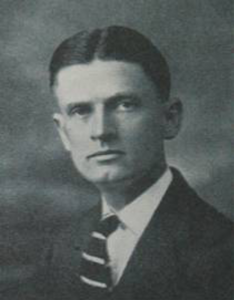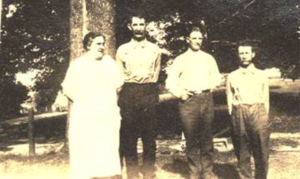Shepherd Flying Field and the Eastern West Virginia Regional Airport
"From an untilled, practically deserted spot early in 1923 the airport has grown into one of the finest fields of its type not only in West Virginia but the entire country, and is known east and west, north and south to the nation’s boundaries, wherever airmen foregather ..."
– Charles McK. Thompson, The West Virginia Review, May 1928

the Father of Aviation in Berkeley County
Alex Parks became interested in aviation as a youngster. His early exposure to the air was through building and flying kites. He later experimented with gliders. In 1916 he learned to fly at Halthorpe, Maryland, near the present site of Baltimore-Washington International Airport.
As a local Martinsburg businessman, Parks envisioned a future for aviation and started the Berkeley Aviation Committee in 1922. This group met, discussed aviation and promoted flying activity in the fields then available. One of the local farmer’s fields used for landings was Kunkle Field, north of Martinsburg. This later became North End Airport or Ruppenthal Field. North End Airport closed in 1953 and became a housing subdivision. Van Metre Field was to the east of town and active only until the late 1940’s.
By 1923, Alex Parks and the Aviation Committee had contact with the Army Airways Office at Bolling Field near Washington, D.C. The first designated airway went from Washington to Cumberland (Mexico Farms) on to Moundsville (Langin Field), then to Dayton, Ohio. The Army was encouraging communities to locate emergency fields along the airway.

The Berkeley Aviation Committee began looking locally to determine which field would best be of service to the newly designated Airway. Studies showed that most traffic went near Pikeside. Van Metre Field being east of Martinsburg, was closer to the airway than Kunkle Field, but both were overshadowed by a property offered by the Shepherd Family further to the south. Shepherd Field was larger and practically on the airway. The Shepherd Family offered this large piece of real estate for use without charge and it would meet the expressed goal of providing an emergency landing site close to the airway with little modification.
The committee selected Shepherd Field and the community was asked for help to prepare the field to meet the government specifications. The community rose to the occasion. With vigor, citizens pitched in with equipment and material to meet the standards. By early May this enthusiastic band of volunteers had the Field prepared and ready for the government inspector. The stage was set for the first landing at Shepherd Field.
Sgt. Roy Hooe, from Charles Town, West Virginia, received lasting recognition for his participation in the flight of the “Question Mark” in 1929. He retired from the Air Force in 1950 and returned to Charles Town to serve as Chief of Police. Sgt. Hooe was later inducted into the Air Force Tankers Association Hall of Fame for his participation in this flight.
HOVER MOUSE OVER PHOTOS BELOW FOR CAPTIONS
The aviation committee incorporated and became the Berkeley Aviation Club. The group operated the field, sold fuel and continued to promote aviation while they encouraged aviation-related business to locate to Shepherd Field.
Army aviators were the most frequent early visitors and within a few years, the Maryland Guard chose Shepherd Field as the location of their summer flying encampments. The encampments always culminated with an air show open to the public. The flying demonstrations attracted thousands of visitors to Shepherd Field and showcased the promise of aviation for the community.
HOVER MOUSE OVER PHOTOS BELOW FOR CAPTIONS
Major William (Shorty) Tipton, seated third from right, was commander of the Maryland Guard. He was a WW1 “Ace” and former POW. Tipton Field near Ft. Meade, Maryland is named after Maj. Tipton. The building behind the group was built in 1926 and was the first building devoted to airport operations. Note “SHEPHERD FIELD” on roof. When this building was later torn down for an airfield taxiway improvement project – portions of the structure’s brick exterior were moved and incorporated into our Airport Terminal’s history museum.
Norman Rintoul arrived in 1930 with Rintoul Flying Service. This was the beginning of a commercial presence at Shepherd Field. Rintoul, while later working for All American Aviation, pioneered Air Mail Pick-Up, a system that snatched mail from the ground without landing. He went on to become Chief Pilot and retired from Allegheny Airlines.
The airport property was finally sold to the Berkeley Aviation Club. In 1934 it was deeded to the city of Martinsburg and became known as the Martinsburg Municipal Airport. Not long afterwards, a Works Progress Administration (WPA) project constructed a 2,350-foot asphalt primary runway and a graded grass crosswind runway.
The early 1940s saw the formation of a local Civil Air Patrol squadron and concrete paving of both the crosswind runway and the primary runway to 5,000 feet of length and 150 feet of width. This allowed larger aircraft inbound from Europe to land with patients for treatment at the Newton D. Baker Army General Hospital nearby (now known as the Martinsburg VA Medical Center). Post-World War II improvements brought additional aircraft hangars and a fixed base operator (FBO) facility.
During this government-regulated era and continuing through the early 1970s, Martinsburg was served with Air Mail and passenger airline service by carriers such as All-American, Allegheny, Penn Central, Potomac Air Transport, Lake Central and Cumberland Airlines.
By the mid-1950s Martinsburg was selected as the new home of the West Virginia Air Guard’s 167th Tactical Fighter Squadron (formerly of the Kanawha Airport in Charleston). In order to accommodate the transfer of this unit an additional 200 acres was acquired and added to Martinsburg’s airport property, taxiway alpha was constructed and the primary runway was extended to 7,015 feet of length. A National Guard complex was constructed and dedicated in 1958. Growth in civilian aviation occurred with a new air terminal building. Thieblot Aircraft Company was built in 1952 and included facilities for engineering, manufacturing, testing and overhauling aircraft, missiles and component systems. Howard Aircraft Maintenance was established in 1956. East Coast Flying Service commenced operations at the airport in 1960.
The 1970s saw the creation of a Regional Airport Authority to govern the airport and the construction of an Armory for the West Virginia Army National Guard. The airport’s name was also officially changed to the “Eastern West Virginia Regional Airport/Shepherd Field”. In the 1980s several additional “t” and box hangars were added along with a local FAA facility and on-airport volunteer Fire Station to serve the northern portion of the South Berkeley district and to further supplement the Guard’s fire station.
By the 1990s, the local Experimental Aircraft Association Chapter was formed, the Airport’s Industrial Park was established along with road and utility improvements and activation of its Foreign Trade Zone designation. A Polo Ralph Lauren Childrenswear Distribution Center was brought online along with a Sino-Swearingen Aircraft plant assembling the SJ-30 business jet. The FAA commenced operations with its ASR-9 regional radar site and Tiger Aircraft broke ground on its manufacturing plant to produce the Grumman Tiger model.
While the Air National Guard base had seen many expansions and improvements over the decades – it was in the first decade of the 21st century that more than $300 million in upgrades occurred allowing the airport and base to host the giant C-5 Galaxy aircraft. Among these major changes was the closure and conversion of the secondary runway 17/35 to become a taxiway, an expansion to the width, length and weight bearing capacity of the primary runway 08/26, larger aircraft parking aprons, improvements to parallel taxiway “A”, new Air Traffic Control Tower, fuel farm, fire station, three new 80,000 sf aircraft hangars, a maintenance mall, base supply, operations facility, simulator facility and base entrance roadway. Also, in the 2000s were additional hangars built to house business jet aircraft associated with the Aero-Smith and later Arcadia FBOs. A new terminal building and Civil Air Patrol facility was opened along with general aviation apron expansion and the addition of Taxiway “E”. Several successful airshows and open-houses were also held in this period that attracted thousands.
Since 2010, the Airport Authority has acquired hangars formerly owned by Howard Aircraft and welcomed the HealthTeam/Air Methods Medical Helicopter and Ground Ambulance service to the airport. Most recently, the D.M. Bowman Warehousing/Trucking/Logistics Firm has announced it will occupy the former Polo Ralph Lauren facility and the West Virginia Army National Guard is occupying the former Thieblot Aircraft plant with plans to expand to the former Sino-Swearingen facility.
In 2020, the EWVRAA acquired the assets formerly owned by the Aero-Smith and Arcadia FBOs, embarking on a new and exciting chapter in the history of our airport – a facility that is likely the oldest continuously operating airfield in West Virginia.
We invite you to come out to the airport to learn more. The lobby of our Terminal Building contains many more photographs, displays and artifacts along with a large selection of aviation-related books in our library. Find a propeller signed by the father of the US Air Force, Billy Mitchell, and a Berkeley Aviation Club membership card from none-other than Miss Amelia Earhart!
